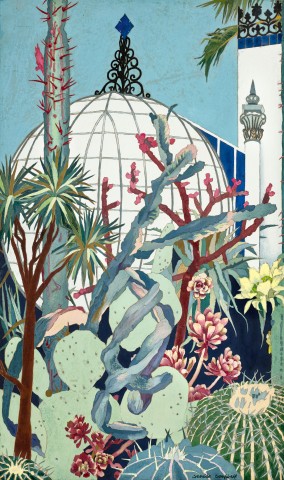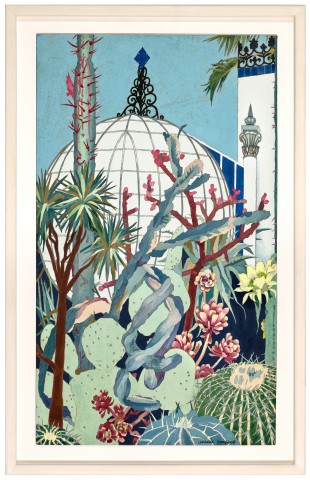CACTI, BOTANIC GARDENS, ADELAIDE, 1987
CRESSIDA CAMPBELL
watercolour on incised woodblock
89.0 x 53.0 cm
signed lower right: Cressida Campbell
signed and inscribed with title verso: Cressida Campbell / ‘CACTII [sic], BOTANIC GARDENS, ADELAIDE’
Christopher Pearson, Adelaide
Private collection
Shapiro, Sydney, 10 December 2001, lot 82 (as ‘Cactus House’)
Private collection, Sydney
Maitland Regional Art Gallery, New South Wales, a gift from the above to raise funds
Private collection, New South Wales, acquired from the above in 2006
Crayford, P., The Woodblock Painting of Cressida Campbell, Public Pictures, Sydney, 2008, cat. W8703, p. 348
Cressida Campbell, National Gallery of Australia, Canberra, 2022, p. 232 (woodblock print illustrated)
A print from this woodblock is held in the Parliament House Art Collection, Canberra
Cressida Campbell is an artist who requires no introduction, having attained through years of fastidious and unwavering commitment, a level of undeniable public and critical recognition for her unique painted and incised woodblocks and their chalky mirrored prints. Cacti, Botanic Gardens, Adelaide, 1987 demonstrates Campbell’s predilection for meticulously constructed images with a masterful handling of design, texture and tone. When painting landmarks of historical and architectural significance, Campbell consistently turns away from clichéd frontal views, instead presenting asymmetric and oblique glimpses, ‘not the sort found on postcards.’1 True to this Japanese sensibility for composition, the vertical view presented within Cacti, Botanic Gardens, Adelaide privileges an obstructive tangle of spiky outlines and bulbous alien forms of a succulent garden in the foreground. Campbell leaves an unconventional view of the gleaming white and sapphire structure of Adelaide’s colonial Palm House, the ‘pride and ornament of the city’2, to vie for attention in the background.
The exquisite Victorian glasshouse, with a sophisticated iron and glass tensile structure made possible through technological developments of the Industrial Revolution, was imported from Bremen in Germany in 1875 at a time of great economic prosperity in the South Australian colony. It is thought to be the only one of its kind still in existence.3 By 1986, however, the corrosion of its iron glazing bars made the building unsafe for public use and it was closed for extensive restoration, only reopening in 1995.4 Campbell’s view of this impenetrable glass palace was probably created while she was visiting Adelaide in the company of her partner, Peter Crayford, whom she married in 1991. While Crayford grew up in regional Whyalla, he attended university in Adelaide and throughout the 1980s maintained strong connections to the city through his role with the Adelaide Film Event.5 Cacti, Botanic Gardens, Adelaide is a rare depiction of this city within Campbell’s oeuvre.
Under a brilliant blue sky painted with a mottled, uneven surface, Campbell presents with flat graphic patterning, the exuberant, wild beauty of an arid desert garden in full bloom. Her pale powdery surface of watercolour pigment after printing is well suited to the range of textures and variegations found in this garden. Although other depictions of cacti within Cressida’s work (Cacti Garden, 1985 and Cacti Garden, Bronte House, 2001) are boldly detailed against a monochrome background, here their forms, dotted with irregular spines, are echoed in the pristine rectilinear columns, glass dome and fanciful ironwork details of the looming architectural structure. Campbell’s botanical luxuriance defies the categorisation and genteel refinement of the colonial botanic garden. Entirely unfettered by manmade structures, the cacti extend beyond the picture frame, snaking across the picture frame and even whimsically peeking out in a spiky sliver along the right-hand edge. The ‘certain wildness in Campbell’s depiction of plant life’6 is a pervasive, and often overlooked, theme within her works, conveying a joyful sense of disobedience and concealing the careful manipulation and orchestration with which the artist has transformed her subject.
1. McDonald, J., ‘Cressida Campbell’, Destination Sydney, The Beagle Press and Manly Art Gallery & Museum, Mosman Art Gallery and S.H. Ervin Gallery, 2015, p. 108
2. ‘The Palm-House in the Botanic Garden’, Evening Journal, Adelaide, 22 January 1877, p. 3
3. Parsons, A., ‘Palm House’, SA History Hub, History Trust of South Australia, see https://sahistoryhub.history.sa.gov.au/places/palm-house (accessed March 2024)
4. ibid.
5. McDonald, J., ‘Peter Crayford’, Australian Financial Review, November 2011
6. Dixon-Smith, I., ‘A Wild Kind of Optimism’, Cressida Campbell, National Gallery of Australia, Canberra, 2022, p. 183
LUCIE REEVES-SMITH


